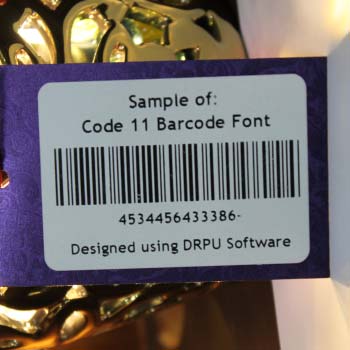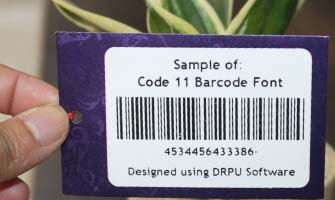Some Related Points of CODE 11 :
-
Code 11 can encode the digits 0-9 and the hyphen (-) character. It is capable of encoding up to 10 digits per barcode, although it is not commonly used for long strings of data.
-
Code 11 is a type of barcode symbology that is used to encode numeric data. It is a relatively simple barcode format that is primarily used for inventory control and tracking applications.
-
Code 11 was developed by Intermec Corporation in the early 1970s and was later standardized by the Uniform Code Council (now GS1 US) in 1980. It is a self-checking barcode that uses a mod 11 algorithm to ensure data accuracy.
-
One of the main advantages of Code 11 is its simplicity. It is a relatively easy barcode format to generate and print, and it can be read by a wide range of barcode scanners and software systems.
-
Limitations of Code 11 is its limited character set. Additionally, it is not capable of encoding long strings of data, which may be a limitation in some applications.
-
While it may not be as versatile as some other barcode formats, its self-checking capability and ease of use make it a popular choice for many organizations.
-
One of the key features of Code 11 is its self-checking capability. The check character is calculated using a mod 11 algorithm, which ensures that the encoded data is accurate. When the barcode is scanned, the scanner reads the data and recalculates the check character using the same algorithm. If the calculated check character does not match the check character encoded in the barcode, the scanner will indicate that an error has occurred.
Download and Install Barcode Software
Related Articles
Applications of Code 11 Barcode
-
One of the main applications of Code 11 is in inventory control and tracking. It is often used to label products, parts, and equipment, allowing companies to easily track their inventory levels and manage their supply chains. By scanning Code 11 barcodes, inventory managers can quickly and accurately record information such as item numbers, descriptions, and quantities, helping to streamline the inventory management process and reduce errors.
-
Code 11 is also used in shipping and logistics applications. It can be used to label packages, pallets, and shipping containers, allowing logistics providers to track the movement of goods through the supply chain. By scanning Code 11 barcodes at various points along the shipping route, logistics providers can monitor the progress of shipments and ensure that they are delivered to their intended destinations on time.
-
Another application of Code 11 is in document management. It can be used to label documents, files, and folders, allowing organizations to easily organize and retrieve their records. By scanning Code 11 barcodes, document management systems can quickly locate and retrieve files, reducing the time and effort required to manage large volumes of paperwork.
-
Code 11 is a barcode symbology primarily used in applications that require a limited amount of data to be encoded, such as inventory control, shipping and logistics, and document management. It is a simple and effective barcode format that is widely used in a variety of industries, including manufacturing, retail, and healthcare.
-
Code 11 is also used in the healthcare industry, where it is often used to label medical equipment and supplies. By scanning Code 11 barcodes on medical equipment and supplies, healthcare providers can quickly and accurately track the location and usage of these items, helping to improve patient care and reduce costs.
In addition to these applications, Code 11 is also used in a variety of other industries and applications, including retail, automotive, and telecommunications. It is a versatile barcode format that is well-suited for applications that require a limited amount of data to be encoded.
How Code 11 Barcode is different from other Barcodes?
Code 11 is a barcode symbology that is different from other barcode types in several ways. In this section, we will discuss the main differences between Code 11 and other popular barcode types.

-
Character set
Code 11 can only encode numeric characters and the hyphen character, unlike other barcode types like Code 128 and QR codes that can encode alphanumeric characters and even binary data. This makes Code 11 ideal for applications that require a limited amount of data to be encoded, but it may not be suitable for applications that require more data to be encoded.
-
Check digit:
Code 11 includes a built-in check digit to ensure the accuracy of the encoded data. This check digit is calculated based on a special algorithm that takes into account the values of the encoded characters. Other barcode types like UPC and EAN also include check digits, but the algorithm used to calculate the check digit is different.
-
Density:
Code 11 has a lower data density compared to other barcode types like Code 128 and QR codes. This means that it can only encode a limited amount of data in a given amount of space. While this may be a limitation for some applications, it also makes Code 11 more easily scannable, even when printed at small sizes.
-
Size:
Code 11 barcodes are typically larger than other barcode types due to their lower data density. This means that they may not be suitable for applications where space is limited, such as on small products or in tight packaging.
-
Printing:
Code 11 can be printed using a variety of printing methods, including thermal transfer, laser printing, and inkjet printing. However, the printing process may require special considerations, such as ensuring that the bars are printed with consistent width and spacing to ensure accurate scanning.
-
Scanning:
Code 11 can be scanned using a variety of barcode scanners, including handheld scanners, fixed-mount scanners, and mobile devices. However, some scanners may not be able to read Code 11 barcodes if they are printed at very small sizes or if they are damaged or poorly printed.
-
Application:
Code 11 is typically used in applications that require a limited amount of data to be encoded, such as inventory management, document tracking, and shipping and logistics. Other barcode types like QR codes and Data Matrix codes are more commonly used in applications where larger amounts of data need to be encoded, such as in marketing and advertising.
In Summary, Code 11 is a simple and effective barcode symbology that is well-suited for applications that require a limited amount of data to be encoded. While it may not be as versatile as other barcode types, its ease of use and self-checking capability make it a popular choice for many organizations.
Structure of Code-11 Barcode
The Code 11 barcode symbology is a continuous, self-checking barcode that is comprised of a series of bars and spaces that represent numeric characters. Code 11 is also known as USD-8, because it can encode up to 8 numeric characters.
The Code 11 barcode structure consists of a start character, a variable-length data field, a check digit, and an end character. Code 11 can encode up to 8 numeric characters, including the hyphen (-) character.
-
Data field:
The data field is the section of the barcode that contains the information being encoded. The data field can be of variable length, which means that the number of characters that can be encoded may vary from barcode to barcode.
-
Check digit:
The check digit is a special character that is used to ensure the accuracy of the encoded data. The check digit is always the last character in the barcode.
-
Start character:
The Code 11 barcode begins with a start character, which is represented by the sequence "110". This sequence is used to signal the barcode reader that a Code 11 barcode is being scanned.
-
End character:
The end character is represented by the sequence "110". This sequence is used to signal the barcode reader that the end of the Code 11 barcode has been reached.
Points to be Remember:
Each character in the data field is represented by a set of bars and spaces that are either narrow or wide. A "0" digit is represented by a narrow bar followed by a narrow space, while a "1" digit is represented by a wide bar followed by a narrow space. The hyphen character is represented by a wide bar followed by a narrow space, followed by a narrow bar and another narrow space.
The barcode reader scans the Code 11 barcode by shining a light onto the bars and spaces and measuring the reflected light to determine the width and spacing of each element. The barcode reader then translates this information into the corresponding numeric characters.
Code 11 also includes a special "stop" character that is represented by a single wide bar followed by a narrow space. This character is used to indicate the end of the data field and the beginning of the check digit.
In summary, the Code 11 barcode structure consists of a start character, a variable-length data field that can encode up to 8 numeric characters, a check digit, and an end character. Each character in the data field is represented by a set of bars and spaces that are either narrow or wide. The barcode reader scans the barcode by measuring the width and spacing of each element and translating this information into the corresponding numeric characters.
Posted By: Techsavvy
|Posted On: 1/May/2023
